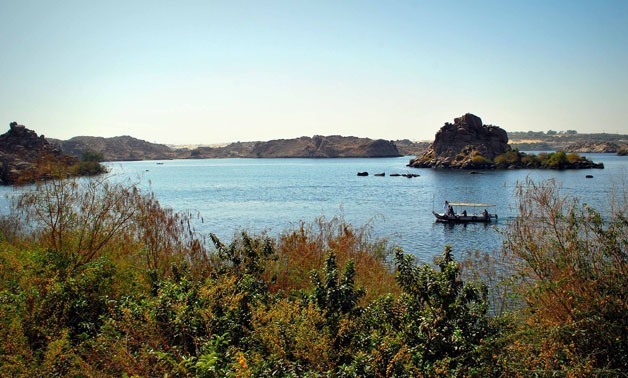
Aswan (Egypt) a branch of the Nile, seen from Isis Island March 10, 2012 – photo courtesy of Wikimedia
CAIRO - 2 March 2018: Water efficiency is considered one of the Egyptian National Security issues, the Nile River is the country’s most important water source.
The ancient Egypt culture was built on the sides of the river, the Nile provides Egypt with 95 percent of its water, in 1902, 1906, 1929 and 1959, Cairo signed agreements with the Nile Basin countries that guaranteed 55 billion cubic meters of Nile water per year for Egypt.
Egypt suffers from a water deficit of 30 billion cubic meters; it annually needs at least 90 billion cubic meters of water to cover 90 million citizens’ needs. However, it currently has only 60 billion cubic meters, of which 55.5 billion cubic meters come from the Nile and just under five billion cubic meters come from non-renewable subterranean water in the deserts.
 view of the Nile River and Cairo - Photo By Hussein Tallal
view of the Nile River and Cairo - Photo By Hussein Tallal
Further decrease in Egypt's water resources is expected amid the construction of the Grand Ethiopian Renaissance Dam (GERD), which could have a negative impact on Egypt’s Nile water share.
Despite the latest negotiations between Ethiopia, Egypt and Sudan to resolve the technical issues of the dam, Egypt is keen to look for new sources of water and to rationalize its usage to overcome any water scarcity problems in the future.
 Grand Ethiopian Renaissance Dam – Reuters
Grand Ethiopian Renaissance Dam – Reuters
Agriculture in Egypt depends heavily on the Nile River, and it consumes 84 percent of Egypt’s water resources; therefore, the State is working on keeping its water security as much as it can through taking some procedures that may help ration water.
The government starts with Agriculture to save water
The government has taken procedures aiming to ration water consumption through preventing the cultivation of crops that need large amounts of water.
Minister of Irrigation and Water Resources Mohamed Abdel Atti decided to reduce the rice agriculture area in Egypt from 1,700,000 feddans to 724,200 feddans (1 feddan = 1.038 acres); According to the ministry this decline will save three billion cubic meters of water. At the same time the ministry is working on launching campaigns to raise farmers’ awareness to reduce water usage.
CAIRO - 27 January 2018: Minister of Irrigation and Water Resources Mohamed Abdel Aty decided to reduce the rice agriculture area in Egypt from 1,700,000 feddans to 724,200 feddans (1 feddan = 1.038 acres).
On the other hand, some experts expect that reducing the rice cultivated areas will lead to a decrease in production, decrease the quantities offered in the markets and lead to higher prices and a trend towards imports to cover the needs of the local market to insure food security.
The Ministry of Agriculture has identified 53 varieties of strategic water-saving crops that are adapted to the different environment and climate conditions, focusing on breeding during the coming period, which included seven varieties of rice.
CAIRO - 16 February 2018: The agricultural sector is considered one of the basic pillars to achieve economic and social development in Egypt, and rice is a key stable foodstuff for millions of Egyptians, but with the government's new water strategy, thousands of rice feddans will be reduced.
Egypt’s national plan for water management
Egypt is preparing a LE 900 billion national plan for water management over the next 20 years in participation with nine ministers to develop solutions for water scarcity, according to Abdel Atti on Sunday.
During the “Egypt Can…With the Sons of the Nile” conference held on Sunday in Luxor and attended by 23 Egyptian international scientists, Abdel Atti remarked that the country allocates LE 70 billion out of LE 900 billion in investments for the crisis of water shortage.
CAIRO - 25 February 2018: Egypt is preparing a LE 900 billion national plan for water management over the next 20 years in participation with nine ministers to develop solutions for water scarcity, stated Minister of Irrigation and Water Resources Mohamed Abdel Atti on Sunday.
Facts about water resources in Egypt
The groundwater in the Nile Valley and Delta is about 6.5 billion cubic meters, rain water on North coast is 1.3 billion cubic meters.
Cairo, Giza and Qalyubia are considered the highest water consuming governorates because of their high populations.
The amount of clean water produced throughout the country in 2016 was 9,297 million cubic meters. The highest rate during the last eight years was in 2012/2013 when it reached 9,727 million cubic meters.
 Amount of clean water produced in millions cubic meters – CC CAPMAS
Amount of clean water produced in millions cubic meters – CC CAPMAS
 Average per capita of produced pure water - Stations year 2011-2012
Average per capita of produced pure water - Stations year 2011-2012
 Drinking water statistics in Egypt 2014/2015 CC CAPMAS
Drinking water statistics:
The number of stations producing pure water 2706.
The quantity of water sold is 6.1 billion cubic meters.
The percentage of loss in pure water produced by the stations is 31 percent.
Drinking water statistics in Egypt 2014/2015 CC CAPMAS
Drinking water statistics:
The number of stations producing pure water 2706.
The quantity of water sold is 6.1 billion cubic meters.
The percentage of loss in pure water produced by the stations is 31 percent.




Comments
Leave a Comment